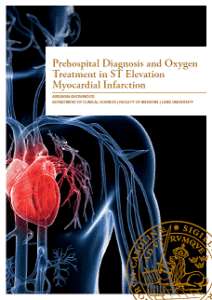Prehospital Diagnosis and Oxygen Treatment in ST Elevation Myocardial Infarction

Introduction
Paper I: An Artificial Neural Network (ANN) was constructed to identify ST Elevation Myocardial Infarction (STEMI) and predict the need for Percutaneous Coronary Intervention - PCI.
Paper II, III and IV: Studies suggest that O2 therapy may be harmful in STEMI patients. We therefore conducted the SOCCER study to evaluate the effects of O2 therapy in STEMI patient.Methods
Paper I: 560 ambulance ECGs sent to the Cardiac Care Unit (CCU), was together with the CCU physicians interpretation and decision of conducting an acute PCI or not collected, and compared with the interpretation and PCI decision of the ANN.
Paper II, III, IV: Normoxic (≥94%) STEMI patients accepted for acute PCI were in the ambulance randomized to standard care with 10 L/min O2 or room air. A subset of the patients underwent echocardiography for determination of the Left Ventricular Ejection Fraction (LVEF) and the Wall Motion Score Index (WMSI). All patients had a Cardiac Magnetic Resonance Imaging (CMRI) to evaluate Myocardial area at Risk (MaR), Infarct Size (IS) and Myocardial Salvage Index - MSI).Results
Paper I: The area under the ANN’s receiver operating characteristics curve for STEMI detection as well as predicting the need of acute PCI were very good.
Paper II, III, IV: No significant differences could be shown in discussing MaR, MSI or IS between the O2 group (n=46) and the air group (n=49). Neither could any differences be shown for LVEF and WMSI at the index visit as well after six months between the O2 group (n=46) and the air group containing 41 patients.Conclusions
Paper I: The results indicate that the number of ECGs sent to the CCU could be reduced with 2/3 as the ANN would safely identify ECGs not being STEMI.
Paper II, III, IV: The results suggest that it is safe to withhold O2 therapy in normoxic, stable STEMI patients.
Ardavan Khoshnood
2017
Doctoral Dissertation, Faculty of Medicine, Lund University
